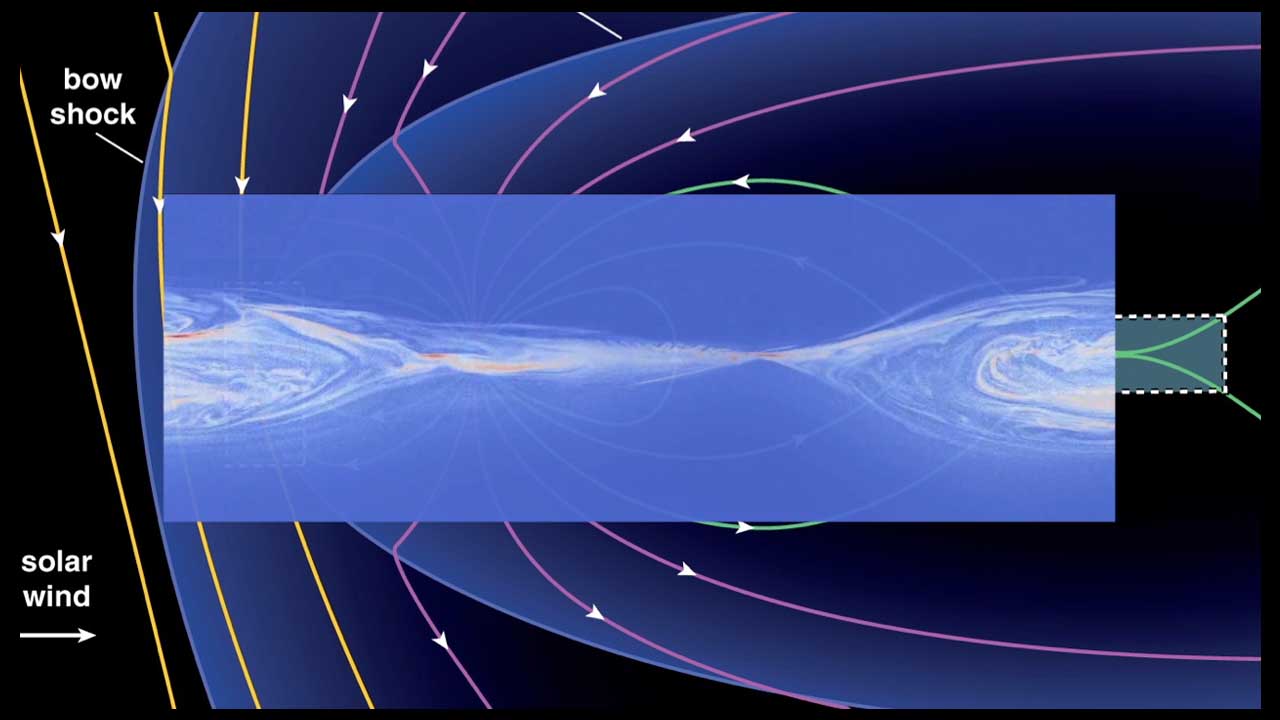MMS L-1 Media Briefing
On March 12 from Cape Canaveral Florida, NASA is scheduled to launch the Magnetospheric Multiscale, or MMS, mission, which will provide unprecedented detail on a phenomenon called magnetic reconnection. The process of reconnection involves the explosive release of energy when the magnetic fields around Earth connect and disconnect. These fields help protect Earth from harmful effects of solar storms and cosmic rays. Magnetic reconnection also occurs throughout the universe and can accelerate particles up to nearly the speed of light.
By studying reconnection in this local, natural laboratory, MMS helps us understand reconnection elsewhere as well, such as in the atmosphere of the Sun and other stars, in the vicinity of black holes and neutron stars, and at the boundary between our solar system’s heliosphere and interstellar space.
MMS consists of four identical observatories that will provide the first three-dimensional view of magnetic reconnection. The four MMS observatories will fly through reconnection regions in a tight formation in well under a second, so key sensors on each spacecraft are designed to measure the space environment at rates faster than any previous mission.
For additional visuals regarding the MMS mission and science, please see our MMS Pre-launch Gallery.
Briefing participants include:
Jeff Newmark, interim director, Heliophysics Division
NASA Headquarters, Washington
Jim Burch, principal investigator, MMS instrument suite science team Southwest Research Institute, San Antonio
Roy Torbert, MMS FIELDS investigation lead University of New Hampshire, Durham, New Hampshire
Craig Pollock, lead co-investigator, MMS Fast Plasma Investigation Goddard Space Flight Center, Greenbelt, Maryland
Paul Cassak, associate professor
West Virginia University, Morgantown

The first four completed DES.
Credit: NASA

One of the MMS spacecraft in a thermal vacuum chamber, as another waits for its turn.
Credit: NASA

The four MMS spacecraft in the clean room at NASA's Goddard Space Flight Center.
Credit: NASA

The MMS spacecraft ready for encapsulation.
Credit: NASA
Animation depicting MMS boom deployment.
Credit: NASA/GSFC/CIL

Deployed ADP Boom.
Credit: ATK Systems
Visualization of magnetic reconnection.
Credit: Paul Cassak
Data of the sun from NASA's Solar Dynamics Observatory (SDO) showing magnetic reconnection in the sun's atmosphere. The image shows the material at 18 million degrees (Fahrenheit). This material, in the plasma state, tends to follow magnetic field lines, so we effectively see the shapes of magnetic field lines. In this movie, we see the magnetic fields pinch together and move out the top and bottom, which is a tell-tale signature of magnetic reconnection. This shows that reconnection happens in the solar atmosphere. Half way through, data from NASA's RHESSI satellite are overlaid on the SDO data. RHESSI shows the plasma that is at 200 million degrees, revealing that the hottest material is located where the magnetic fields move away from the reconnection site. This shows how important reconnection is for producing energetic charged particles. No audio.
Credit: NASA/GSFC
Data of the sun from NASA's Solar Dynamics Observatory (SDO) showing magnetic reconnection in the sun's atmosphere. The image shows the material at 18 million degrees (Fahrenheit). This material, in the plasma state, tends to follow magnetic field lines, so we effectively see the shapes of magnetic field lines. In this movie, we see the magnetic fields pinch together and move out the top and bottom, which is a tell-tale signature of magnetic reconnection. This shows that reconnection happens in the solar atmosphere. Half way through, data from NASA's RHESSI satellite are overlaid on the SDO data. RHESSI shows the plasma that is at 200 million degrees, revealing that the hottest material is located where the magnetic fields move away from the reconnection site. This shows how important reconnection is for producing energetic charged particles.
Credit: Paul Cassak and Michael Shay.

Images of FPI - Dual Plasma Spectrometers
Credit: NASA

Magnetic reconnection in the Earth's magnetosphere.

Images from simulations of magnetic reconnection at 100, 000 km, 500 km, and 100 km.
Credit: NASA
Credits
Please give credit for this item to:
NASA's Goddard Space Flight Center
Release date
This page was originally published on Wednesday, March 11, 2015.
This page was last updated on Wednesday, May 3, 2023 at 1:49 PM EDT.
